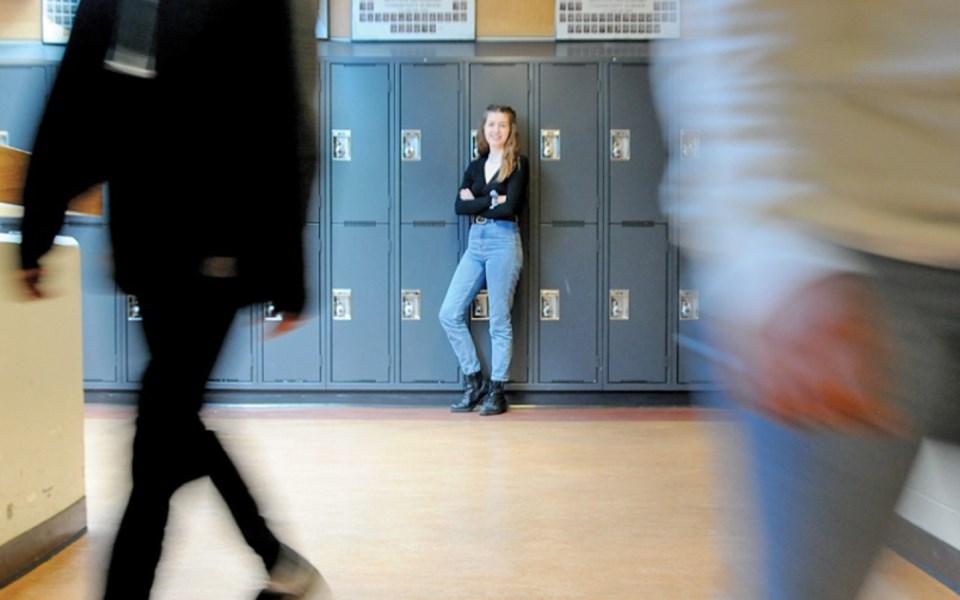Isobel Casey says you would be hard-pressed to find a teen who hasn't at least tried vaping.
The Grade 11 Seycove Secondary student is so concerned about the recent rise in student vaping that she decided to speak out about the issue during a forum on youth and vaping hosted by Foundry North Shore and the North Vancouver School District Monday night.
"Over the last two/three years, I've seen the devices of vaping affect many people," she said. "Today, I would say most people in my year vape, or almost everyone has tried it. I know one person in my school who's never tried vaping."
Vaping involves using a device, such as an e-cigarette, to heat a liquid into vapour that then turns into aerosol which is exhaled.
Addressing a packed room at the school district's Education Service Centre, Casey described how vaping was originally thought of by her peers as a safer alternative to smoking cigarettes, but for many has now become an addiction.
"Soon, nicotine got introduced and then people started to get addicted, more people did it, it became cool and then this became normal. Now vaping in class – I don't even take a second look at it," said Casey.
In December, Seycove made national headlines after school administrators decided to temporarily lock a number of its washrooms in order to deter students from vaping in them, which had become rampant.
While vaping has been around for more than a decade, the sale of nicotine vaping products wasn't legal at the federal level until last year's Tobacco and Vaping Products Act was passed in order to regulate the sale, labelling and promotion of products sold in Canada.
That was intended to "tread that line between protecting youth and making e-cigarettes containing nicotine available for adult smokers," said Dr. Milan Khara, an addictions physician with Vancouver Coastal Health, who spoke at Monday's forum.
And while it's still illegal for minors in B.C. to purchase e-cigarettes, that hasn't stopped the era of "Big Vape" from finding its way into Canada, he said, with companies like Juul and Vype likely attracting new adult and teen smokers with their products, which feature sleek, compact designs and a variety of flavours.
Responding to reports from around the country of a rise in young people vaping, Health Canada unveiled a plan in early February to put more restrictions on the types of advertisements vape companies are allowed to produce, and began rolling out a more robust public education campaign aimed at teens.
Citing data from the U.S., Khara said when high school students in 2017 were asked if they had used an e-cigarette in the last 30 days, under 12 per cent answered yes, while last year that number appears to have doubled.
Unfortunately, there is currently a lack of data on vaping and e-cigarette use in Canada because it has only recently became officially legalized and regulated, said Khara.
"In the next year or two, when we start to see our provincial numbers, I suspect they'll look very much like this," he said.
The school district is taking a two-fold approach in dealing with the sudden increase in student vaping, said Deneka Michaud, spokeswoman for the North Vancouver School District.
If students are caught vaping, the vaping products will be confiscated and disciplinary actions could range from meeting with the principal, to meeting with parents, to not being able to participate in extracurricular activities, to suspensions, said Michaud.
The second aspect, she said, is education.
"One thing that is shocking to a lot of people, particularly to parents who don't vape and don't smoke, is the fact that there actually is a lot of nicotine in most of these products," she said.
"When these came out a decade ago or so ... they were marketed as a cessation device."
Large educational posters are currently being placed throughout the school district with information for students about why vaping is banned, what the consequences could be, and what they can do about it, said Michaud.
She added that all schools are also providing their own educational sessions on vaping, whether that's through school assemblies, having the district's tobacco reduction co-ordinator give presentations, or getting other substance and addictions education organizations to provide workshops.
When the panel during Monday's info session – which also included Seycove principal Pamela Craven and Argyle Secondary parent advisory council co-chair Tannis Hendriks – were asked why young people were drawn to vaping in the first place, Khara said it followed the same trajectory as people who had taken up smoking tobacco products a generation earlier.
"They do it to look cool, to fit in, all those kinds of extrinsic reasons," he said.
"It's become the thing to do," Hendriks remarked.
Although there's some evidence to suggest that vaping could be less harmful than traditional cigarettes, Khara warned that e-cigarette use could ultimately lead to more fervent nicotine consumption.
"Our other concern is when individuals get addicted to nicotine there is a danger that they will graduate to the most efficient nicotine delivery system that we know of, which is the traditional cigarette."
The original version of this story can be viewed here.




